In the competitive landscape of metal fabrication, procurement managers and wholesale buyers seek finishing processes that deliver on three core metrics: durability, aesthetic value, and production efficiency.
Dye sublimation on metal is not merely a printing method; it is a high-performance surface finishing technology that permanently fuses imagery into the metal’s coating at a molecular level. This creates a finish that resists fading, scratching, and moisture far more effectively than surface-printed alternatives.
This guide provides a technical blueprint for understanding this process. We will explore the science, the materials, the quality control metrics, and the strategic applications that are critical for making informed purchasing decisions and leveraging this technology for high-value commercial and industrial products.
Section 1: The Unbreakable Bond — The Science of Fusing Dye into Metal’s Polymer Coating
From a manufacturing perspective, understanding how metal sublimation works begins with one critical fact: raw, untreated metal cannot be sublimated. The entire process is enabled by a specialized, receptive polymer coating that acts as the essential bridge between the metal substrate and the sublimated image.
This sublimation polymer coating is an engineered surface. For aluminum, it is typically composed of robust epoxy resins and hardeners. For other substrates like stainless steel, a polyglass base may be used to ensure superior adhesion and resistance to thermal stress.
During the heat press cycle, at temperatures around 400°F (205°C), the solid dyes in the sublimation ink transition directly into a gas. Simultaneously, the heat opens the molecular structure of the polymer coating. The gaseous dye is drawn into these pores and, as the panel cools, becomes permanently trapped. This molecular encapsulation creates the unbreakable bond that defines the durability of the finish—resistant to UV light, abrasion, and chemical exposure.
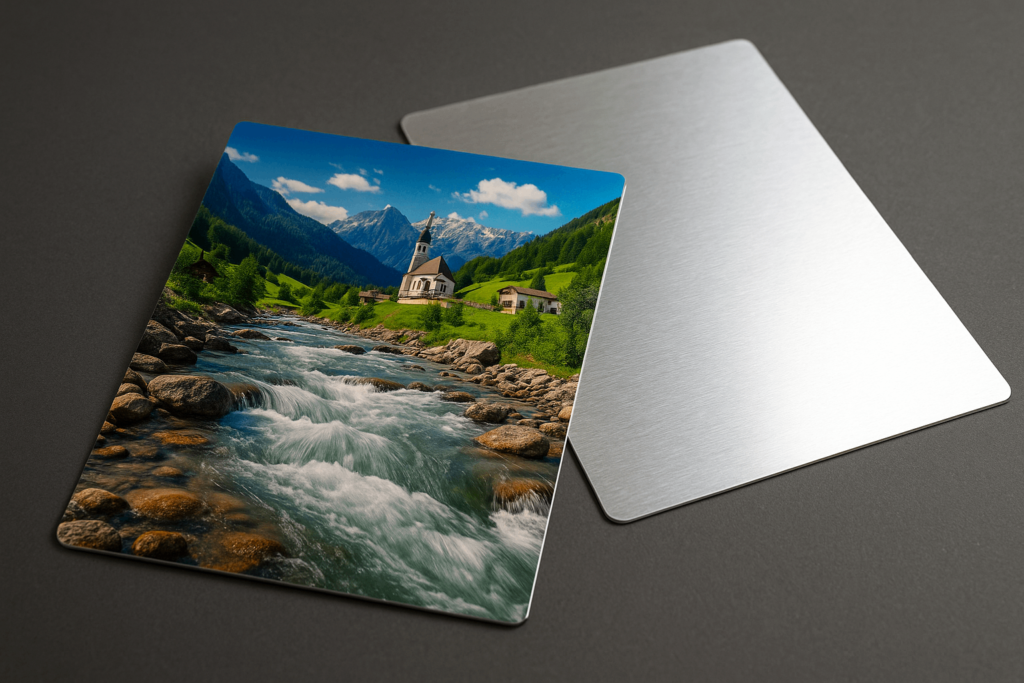
Section 2: Choosing Your Canvas — A Fabricator’s Guide to Metal Substrates
For wholesale buyers, selecting the right substrate is a crucial decision that impacts cost, performance, and marketability. The best metal for sublimation is determined by the project’s specific performance requirements and the end-use environment.
Aluminum: The Industry Standard for Performance and Efficiency
Aluminum is the dominant choice for high-definition sublimation, offering key advantages for bulk production and logistics. Its excellent thermal conductivity ensures a fast and even heat transfer, which is vital for maintaining quality control and consistency across large orders.
Furthermore, its lightweight yet rigid nature significantly reduces shipping costs and simplifies on-site installation, especially for large-format architectural or signage projects. Combined with its corrosion resistance, aluminum stands out as the most reliable and efficient choice for sublimated metal products.
The Critical Impact of Finish on Product Application
The finish of the metal sublimation blanks is a key specification that defines the product’s final look and ideal use case:
- White Base for True Color Fidelity: This is the most versatile option. An opaque white polymer coating provides a neutral canvas, ensuring the most accurate and vibrant color reproduction. This finish is essential for photographic art and corporate branding where color accuracy is non-negotiable.
- Clear/Silver Base for a Modern Aesthetic: A clear coating allows the brushed aluminum’s metallic grain to show through. Since sublimation does not print white ink, any white in the design becomes transparent, revealing the metal. This creates a contemporary, industrial look popular in modern interior design and high-end signage.
Beyond Aluminum: Niche Applications for Steel and Brass
While aluminum is the primary choice, other metals offer unique properties for specific applications:
- Sublimation on Stainless Steel: Valued for its extreme durability, stainless steel is ideal for items like commercial drinkware, control panels, and industrial asset tags. It requires a specialized polymer coating to ensure proper dye adhesion and may need adjusted press settings due to its heat retention properties.
- Sublimation on Brass: For decorative plaques and high-end nameplates, brass offers a classic, warm aesthetic. It also must be pre-coated and is typically specified for bespoke, premium projects where visual appeal and durability are equally critical.
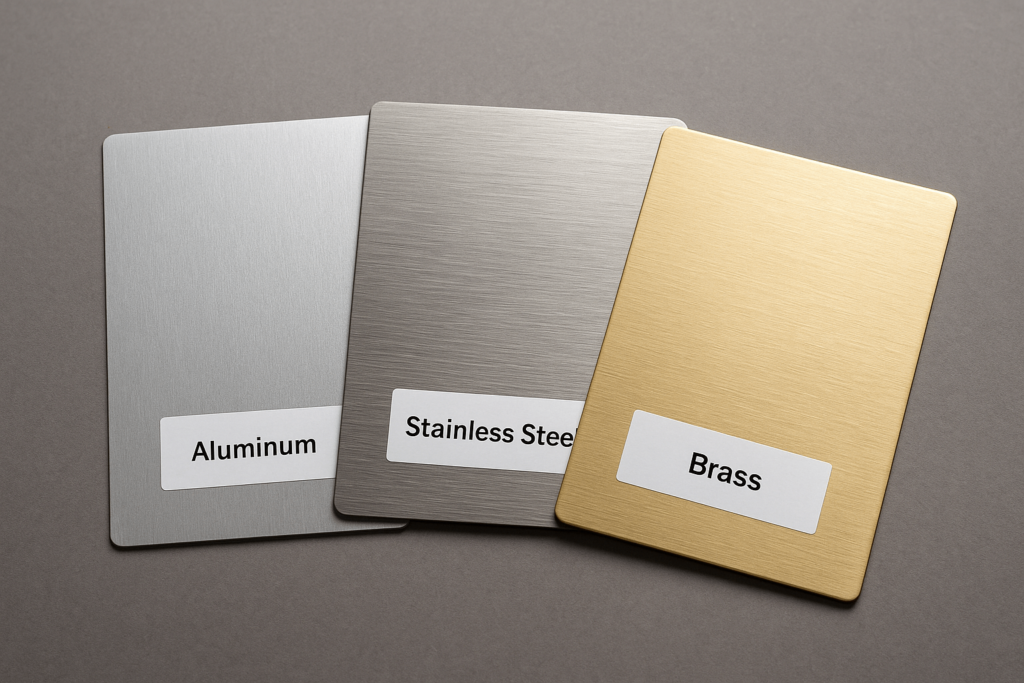
Section 3: The Master’s Workflow — A Step-by-Step Process for Flawless Results
A disciplined and repeatable workflow is essential for producing consistent, high-quality sublimated metal products at scale. Each stage is a critical control point.
1. Digital Preparation
A flawless digital file is the foundation of a quality print. The image resolution must be a minimum of 300 DPI (dots per inch) at the final print size to ensure sharpness and detail fidelity.
Before printing, the image must be mirrored (flipped horizontally) in the design software. This ensures the final orientation is correct. A “bleed” area of 0.125″ to 0.25″ should also be added around the design to prevent white edges from minor misalignments during pressing.
2. Substrate Preparation
The metal panel must be impeccably clean. First, carefully peel off the thin, protective plastic film from the coated surface. Then, wipe the panel with a lint-free cloth and isopropyl alcohol to remove any dust, oils, or fingerprints that could cause defects in the final finish.
3. The Pressing “Sandwich”
Correct layering in the heat press is vital. The stack, from bottom to top, should be:
- Protective Paper
- The Metal Panel (face up) with the Transfer Paper (face down) taped securely to it
- A final sheet of Protective Paper
For larger panels, a Nomex felt pad beneath the assembly ensures perfectly even heat and pressure distribution, reducing the risk of defects such as uneven transfer or ghosting.
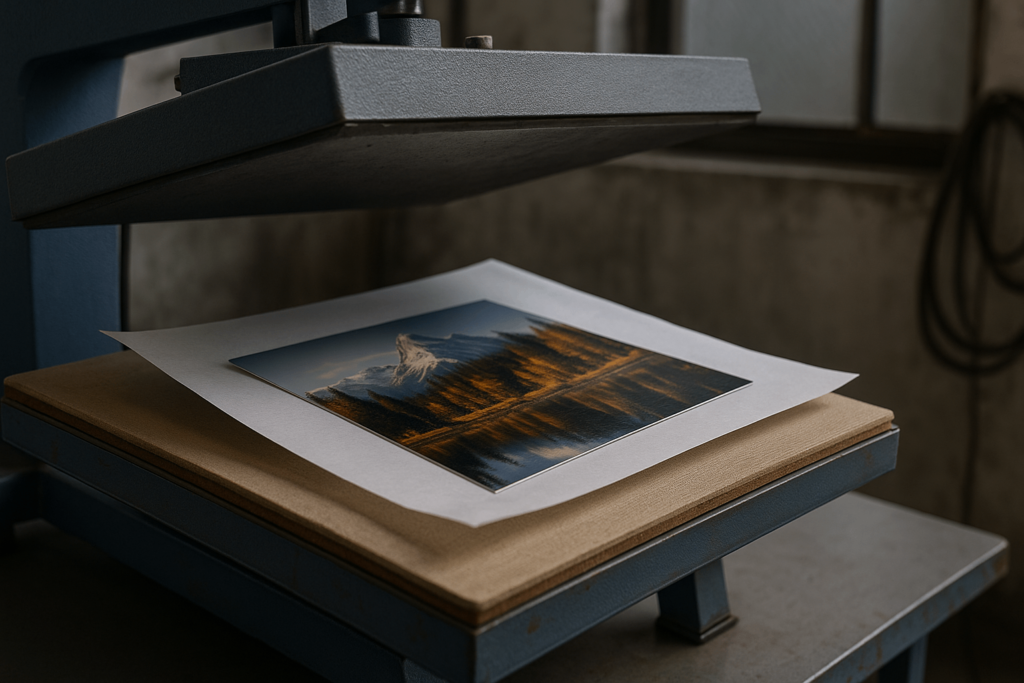
4. Dialing in the Variables (Time, Temp, Pressure)
These three variables are critical. The following table provides baseline heat press settings, which should be calibrated for your specific equipment and panel type:
| Substrate Type/Brand | Panel Size | Temperature (°F / °C) | Time (seconds) | Pressure |
|---|---|---|---|---|
| Unisub White Aluminum | Small (e.g., 4″x6″) | 400°F / 205°C | 60 | Medium (40 psi) |
| ChromaLuxe Gloss Aluminum | Medium (e.g., 8″x10″) | 400°F / 204°C | 90–120 | Medium-High |
| ChromaLuxe Gloss Aluminum | Large (e.g., 16″x20″) | 400°F / 204°C | 180 | High |
| ilumipiX™ HD Photo Panel | Medium (e.g., 8″x10″) | 400°F / 205°C | 85 | Light |
5. The Reveal
Immediately after the press cycle ends, open the press and, wearing heat-resistant gloves, remove the transfer paper in one smooth motion. Any delay can cause “ghosting,” a faint double image. Place the hot panel on a flat, cool surface to prevent warping as it cools.
Section 4: Quality Control — A Professional’s Troubleshooting Checklist
For wholesale orders, quality control is paramount. This checklist helps diagnose and solve common production issues to minimize defect rates:
| Issue | Description | Likely Cause(s) & Solutions |
|---|---|---|
| Faded or Washed-Out Colors | The image lacks vibrancy and appears dull. | Cause: Insufficient heat, time, or pressure; printing on the wrong side of the paper. Solution: Verify press settings against manufacturer specs. Ensure printing is on the bright white side of the paper. |
| Ghosting or Blurring | A faint, shadow-like double image is visible. | Cause: The transfer paper shifted during or after pressing. Solution: Securely tape the paper to the panel. Remove the paper immediately and cleanly after pressing. |
| Random Dots or Blemishes | Small, irregular colored dots appear on the surface. | Cause: Moisture turning to steam; dust or debris on the substrate. Solution: Pre-press the substrate for a few seconds to remove moisture. Thoroughly clean the panel before pressing. |
| Uneven Color/Transfer | Parts of the image are faded, often near the edges. | Cause: Uneven heat or pressure from the press. Solution: Use a temperature gun to check for cold spots. For large panels, a high-quality press and a Nomex pad are essential. |
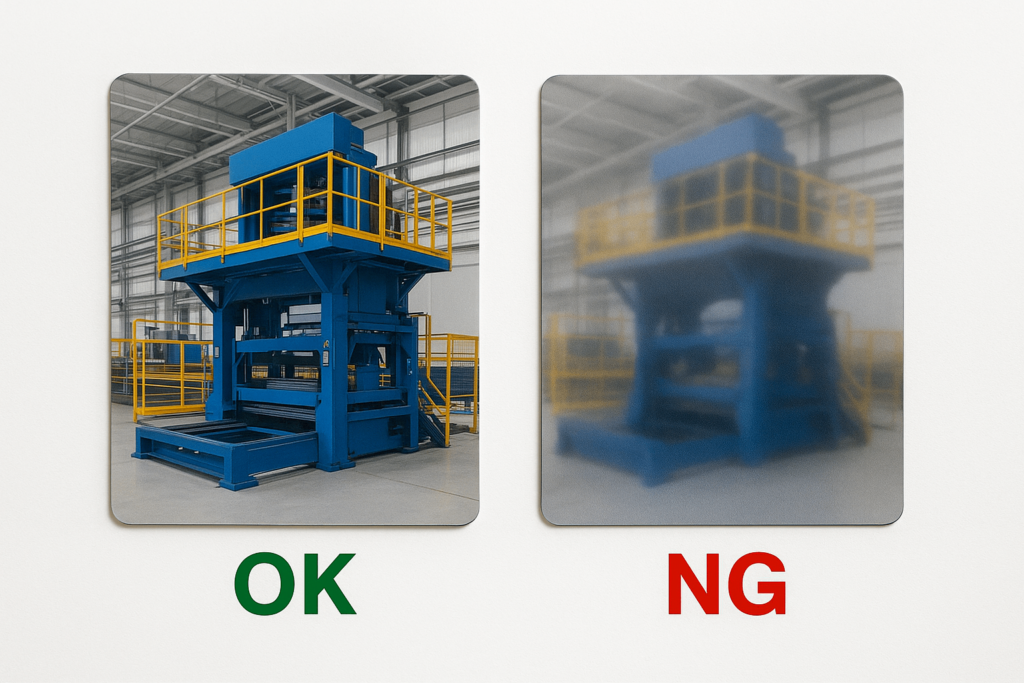
Section 5: Real-World Applications — Where Sublimated Metal Excels
Understanding the real-world potential of sublimation on metal can empower procurement professionals to identify profitable applications that extend beyond traditional signage. While photography and artwork remain dominant, there is growing adoption across architecture, advertising, and OEM manufacturing.
Commercial and Industrial Interiors
Architects and developers increasingly favor sublimated aluminum panels for lobbies, hospitals, airports, and retail environments. Unlike vinyl wraps or painted surfaces, sublimated metal panels provide photographic clarity combined with Class A fire ratings and exceptional cleanability.
For example, wayfinding systems, elevator cabs, and architectural murals often use sublimated ChromaLuxe panels due to their dimensional stability and long-term indoor/outdoor performance. Metal prints resist graffiti and chemical cleaning agents, making them suitable for high-traffic public spaces.
OEM and Equipment Branding
For manufacturers in sectors like medical devices, commercial kitchen appliances, or vending machines, sublimated metal allows for durable branding plates, instruction panels, and control faceplates that withstand heat, solvents, and wear.
Because the ink is embedded within the coating, the image won’t peel or scratch off like a decal. This reliability is crucial in mission-critical industrial and commercial environments.
Promotional and Corporate Products
From branded gifts to executive awards, sublimation on metal offers a premium finish that elevates perception. For example, aluminum plaques, desktop nameplates, or trade show display panels can be customized in short runs without sacrificing visual impact.
Fine Art and Photography
The art world widely considers dye sublimation on aluminum—particularly white-coated glossy panels—as the gold standard for photographic reproduction. The depth, detail, and contrast are unmatched by canvas or paper prints.
For galleries and print-on-demand studios, sublimation offers consistent results with low return rates, making it a preferred option for collectors.
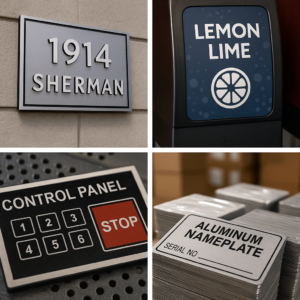
Section 6: Sublimation vs. Competing Technologies — What Buyers Should Know
To make the most informed decision, it’s essential to compare sublimation with other common metal finishing techniques. Here’s how sublimation compares to UV printing and screen printing across key buyer criteria:
| Criterion | Dye Sublimation on Metal | UV Direct Printing | Screen Printing |
|---|---|---|---|
| Durability | Excellent — Image is embedded | Moderate — Surface-level ink | Good — Durable ink but can fade |
| Color Vibrancy | Very High — Vivid, photographic | High — Saturated, but flatter | Moderate — Color limited by screen |
| Scratch Resistance | High — Polymer-sealed | Medium — Coating required for best | Low to Medium |
| UV/Weather Resistance | Excellent (outdoor-rated coatings) | Variable — Needs UV-resistant ink | Variable |
| Production Efficiency | High — Fast cycle with heat press | High — Ink cures instantly | Medium — Screen setup time required |
| Minimum Order Volume | Low — Easy short-run customization | Low — Ideal for small batches | High — Economical only in bulk |
| Finish Aesthetics | Glossy, matte, metallic options | Typically matte/semi-gloss | Limited by ink and mesh |
Summary:
- Choose Sublimation for applications needing photo-quality detail, premium appearance, and strong resistance to environmental wear.
- Choose UV Printing for flat, non-coated metals or when time is tight and substrates are varied.
- Choose Screen Printing for very high-volume orders with simple graphics and one- or two-color prints.
Conclusion: From Finish to Function — Why OEM Buyers Choose Sublimated Metal
Dye sublimation on metal isn’t just a decorative finish—it’s a long-term surface strategy for OEM-grade durability, clarity, and environmental resistance.
Whether you’re sourcing custom sublimation metal panels for wholesale, specifying photo-quality brushed aluminum signage, or comparing UV printing vs sublimation durability, this method offers unmatched performance for architectural, industrial, and branded products.
With 26+ years in metal fabrication, YISHANG supports global OEM buyers with CNC machining, sublimation-ready coatings, and export packaging. We deliver high-precision, batch-ready components for bulk sublimated signage, equipment branding plates, and more.
Contact us today to request samples, validate coating specs, or schedule your next custom run. Let’s build durable, stunning metal products together.

